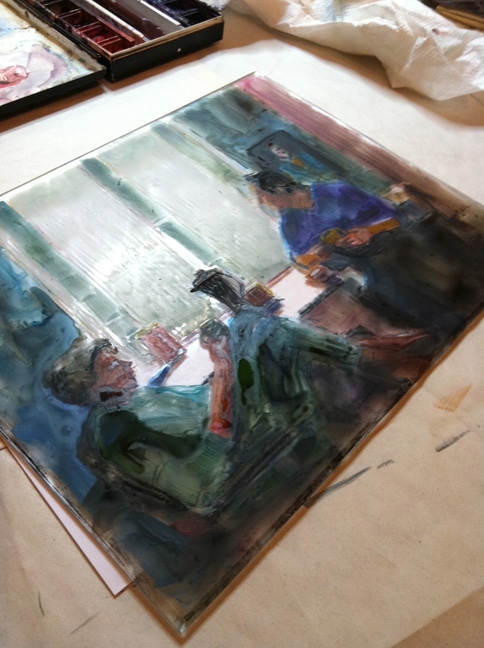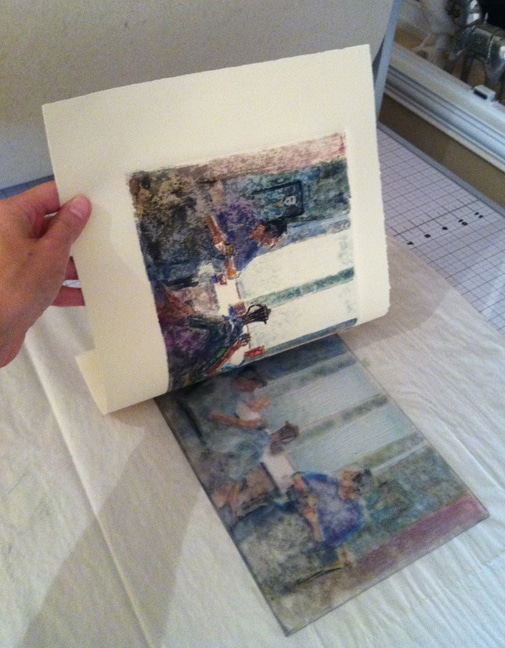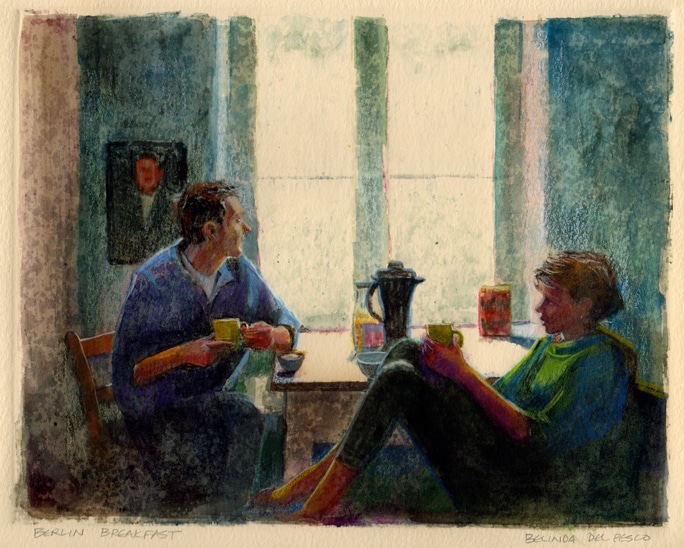Monotype Video Course
I’ve been listening to podcast interviews with other artists while filming a dark field monotype course.
Hearing other artists discuss their journey reminds me about what I didn’t know when I first started printmaking. It’s important to roll time back, and recall the minutiae of our own beginnings with any art process, if we want to teach it well. Don’t you think?
I’m excited to start editing and narrating the clips, because this course will demystify some of the assumed requirements to making monotypes.
The wall in my studio is covered with 6 x 6 inch dark field monotypes of land and seascapes, people, animals, and still life prints. Some were made from plexiglass plates, and others were pulled from metal, or gelli, or tin foil and cardboard plates.
A few were printed with ink, and many were printed from watercolor, or acrylics.
Monotype Printing Without a Press
I didn’t use my press to create any of the monotypes in this course.
Each print was transferred by hand, with a variety of tools, since most artists don’t have a press. And the field of monotype and monoprint tutorials is already loaded with patterned, stenciled abstract demonstrations, so I’m focusing on representational monotypes; images of life and things we recognize, etc.
Now, I need to cull through hours and hours of footage – and pare things down to decide which monotype demonstrations will transfer knowledge the best by watching the process with narration from start to finish.
(If you want to be notified when the course is published, click here.)
Artist’s Stories
In between filming this week, I read some essays, watched some process videos, and listened to a few great podcasts.
There is *so much* good content being produced out there, it just stuns me! Here are some links to the things I found noteworthy this week.

Printmaking Links for You
- David Begley makes ethereal, figurative monotypes that often appear to be arranged in a star field. This article came out during an exhibit he had in 2017, and there are photos of his working process while creating his dark field monotypes using a light table. Check it out here.
- If you’ve never seen a printmaker print a traditional Japanese Ukiyo-e woodcut, watch this video. In a fast paced, everything coming at you all at once world, watching this man’s graceful, lovingly performed process to ink and print hand carved blocks is mesmerizing.
- Ann Dinkelspiel is a Berkley, California psychologist, and an oil painter. This week, she posted a thought provoking essay on Six Ways to Silence Your Inner Critic. If you’ve been nagged about your art by that ill-tempered little booger residing in your own head, read her article, and kick that curmudgeon to the curb.

Monotype Resources
In case you’re itching to get some monotype printmaking rolling off your dining room table (because, after all, school is back in session, and little ones can’t interrupt), you can warm up with a self-paced monoprint course by printmaker Linda Germain here.
There is also a playlist of demos on YouTube over here.
And, even though the book Monotype – Mediums and Methods for Painterly Printmaking by Julia Ayers is 28 years old – it’s still so viable! The book is chock full of demonstrations, examples, materials and considerations. I’d recommend it for anyone looking to explore this painterly printmaking method.
Which are your favorite printmaking resources? Leave us some printy links in the comments. ?
Thanks for stopping by and I’ll see you in the next post!
Belinda
P.S. You can subscribe to get each new post as soon as it’s published via email by signing up (free) here.

Art Quote
Imagination does not become great until human beings, given the courage and the strength, use it to create.
Maria Montessori




I thoroughly enjoy reading your blog. So much useful information and links. I was fortunate today in picking up a copy of Julia Ayres book at a Lifeline book fair. I couldn’t believe my luck. The book was published 28 years ago!! Although I had read a borrowed copy and made a lot of notes, having my own copy is wonderful.
I’m looking forward to your video.
Cheers
Hilary
Hi Hilary! What good luck! That book is excellent, and I didnt realize it was first published 28 years ago. My copy must be a reprint. I’ll adjust my verbiage in this post. Thanks so much for your compliments and encouragement. This is all so much fun!
Because of your great YouTube video I have been experimenting with dry point etchings printing with a pasta rolling machine and a loaned 12″ table top press for larger prints. I love the process and want to try printing over some prints made on my home made permanent gelatin plate. These gelatin prints are mostly printed on card stock so I am not sure they will stand up to soaking. I also want to try making a mat board printing plate I saw in one of your other videos. I did stone lithography in college and this experimentation is much more fun. Thank you for showing us your techniques and your beautiful art! (Sent from Berkeley with 3 e’s 🙂 )
Hi Madelin! I’m grinning! Your printmaking adventures sound WONDERFUL! I love that you’ve launched in all directions. It’s exactly what I do when curiosity and creative inspiration collide. For your card stock, try spritzing and blotting the surface you’ll be printing on before feeding through the press(es), unless you used acrylic paints. Acrylics seal the paper, so try printing dry, first, and if there’s not enough flexibility in the paper to get to the drypoint ink, try spritzing and blotting the back of the card stock. If the drypoint on gelli doesn’t work, try trace monotype on them. It’s GORGEOUS! Leave us a link where we can find your work online! Thanks for the compliment! Happy printing to you!
I’m looking forward to your video on dark field monotypes. I’ve been using that technique on and off for six or seven years. The Cran D’Ache crayons are my favorites for this swell as for making screen-printed monotypes. By thickly layering the crayon marks I find I can usually pull at least a couple of ghost prints worth keeping. Your painting skills serve you very well in this light-field print. Just beautiful!
Hi Dan, Yayyy for monotypes! Another printmaker is in the house! The Caran D’Ache crayons are indeed lovely! Have you tried the Sabilo 3-in-1 woody pencils? ( https://amzn.to/2N9SHGS ) They’re meant for kids, but I qualify in that category. ? They’re a stiffer pigment, so they’re good for details. Thanks for your compliment. I hope you do get into some more printmaking soon. Share them over in our Monotype Group if you make something!